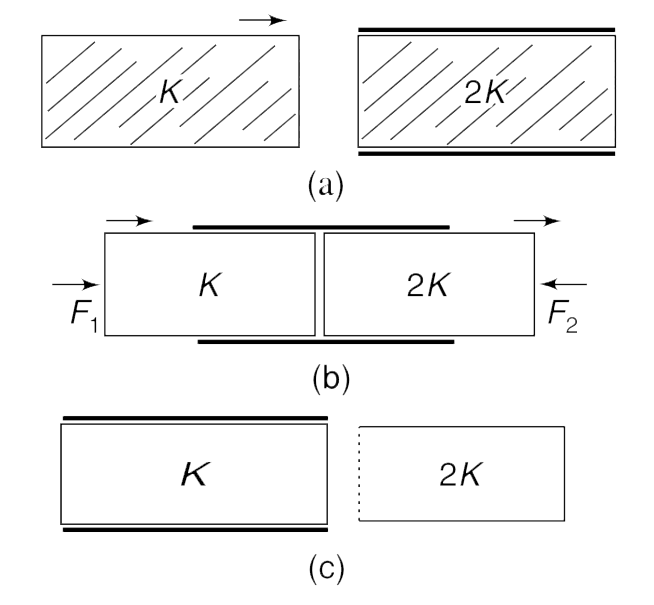Effect of Dielectric slab on capacitance|Polarisation of Dielectric slab#!#Force on Dielectric slab
Step by step video & image solution for Effect of Dielectric slab on capacitance|Polarisation of Dielectric slab#!#Force on Dielectric slab by Physics experts to help you in doubts & scoring excellent marks in Class 12 exams.
Updated on:21/07/2023Similar Questions
A parallel-plate air capacitor of plate separation 2mm and capacitance 1μF is charged to 100V. A dielectric slab of relative permittivity 50 is now inserted so as to fill the space between the plates. (i)Find the polarisation charge on one of the boundaries of the dielectric slab. (ii) Find the magnitude of the polarisation of the dielectric slab. (ε0=8.85×10−12C2/N.m2)
View SolutionFind an expression for the capacitance of a parallel plate capacitor when a dielectric slab of dielectric constant K and thickness t=d2 but the same area on the plates is inserted between the the capacitors plate. (d=separation between the plates)
View Solution
Knowledge Check
In figure , there are two patterns of electric field lines absent of dielectric and in presence of dielectric slab. The relative permittivity of the dielectric slab is
 , A53B53×ε0C4D52
, A53B53×ε0C4D52A parallel plate capacitor with a dielectric slab with dielectric constant k=3 filling the space between the plates is charged to potential V and isolated. Then the dielectric slab is drawn out and another dielectric slab of equal thickness but dielectric constant k'=2 is introduced between the plates. The ratio of the energy stored in the capacitor later to that initially is:
A2:3B3:2C4:9D9:4A parallel plate capacitor without any dielectric has capacitance C0. A dielectric slab is made up of two dielectric slabs of dielectric constants K and 2K and is of same dimensions as that of capacitor plates and both the parts are of equal dimensions arranged serially as shown. If this dielectric slab is introduced (dielectric K enters first) in between the plates at constant speed, then variation of capacitance with time will be best represented by :
 A
A B
B C
C D
D
An air core parallel plate capacitor has capacitance C. It is completely filled with a dielectric slab having dielectric constant 2 K. The capacitor is now connected to a battery of emf V. It was planned to replace the dielectric slab of the capacitor while it remains connected to the battery. Another dielectric slab (which fits exactly between the plates) is inserted slowly so as to push out the earlier slab. The new slab has a dielectric constant K [see Figure (a) to (c)]
(a) By energy considerations calculate the mechanical work that must be done against the electric forces in order to complete the process.
(b) Looking at the expression of mechanical work obtained in (a), tell what was the direction of force applied by the external agent - from left to right (as indicated by F1 in Figure) or from right to left (as indicated by F2).
(c) Which dielectric slab experienced higher force of attraction from the capacitor plates during the process ?

View SolutionWith the help of neat diagrams, explain how the nonpolar dielectric material is polarised in external electric field of increasing intensity. Define polarisation in dielectrics.
View SolutionA capacitor having a capacitance of 100μf is changed to a potential difference of 50V.(a) What is the magnitude of the charge on each plate? (b)The charging battery is disconnected and a dielectric of dielectric constant 2.5 is inserted . Calculate the new potential difference between the plate .(c) What charge would have producted this potential difference in absence of the dielectric slab.(d) Find the charge induced at a surface of the dielectric slab.
View SolutionThe strength of electric filed in the charged and isolated capacitor is decreased when the dielectric slab is inserted.
When the dielectric slab is inserted between the plates of a charged capacitor, electricfield produced due to induced charged, opposite to the external field.
View SolutionA parallel plate capacitor having capacitance C farad is connected with a battery of emf V volts. Keeping the capacitor cannected with the battery, a dielectric slab of dielectric constant K is inserted between the plates. The dimensions of the slab are such that it fills the space between the capacitor plates. Then,
View Solution
